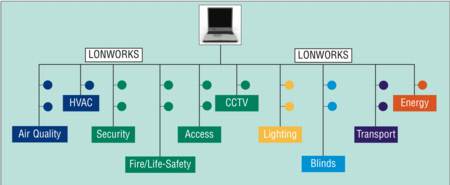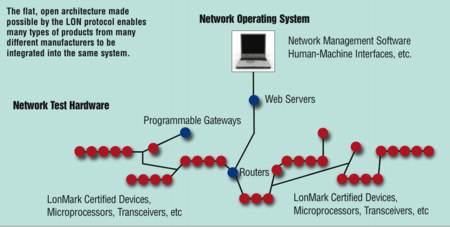Over a decade of LonWorks
The LON communication protocol has a history stretching back about 15 years, and is firmly placed as a control technology for future generations, as Ron Bernstein explains.The concept of a control networking architecture, which provides fair competitive bidding on all levels of a system and over the life of the system is something the user market has been demanding for years. LON and other network protocols, such as BACnet, ModBus, and Zigbee, have been developed to deliver on this need. In this vein, defining new rules and a structure for interoperation allowed for competing manufacturers to sit down at a neutral table and design for the betterment of their industry. Though a monumental task, it was fuelled by the desire to grow the market from a level playing field — irrespective of company size and market dominance.
 |
A huge range of building systems can be integrated on a single network using the LON protocol. |
By creating a common ‘language’ that allows developers to focus on their applications, development times for new products are greatly reduced, and the effort to make products interoperable is simplified. It also provides the added benefit of enabling the many different control systems to work more cohesively in the same system. Functions such as HVAC, lighting, access, security, energy monitoring, indoor air quality, irrigation, elevators, life safety, and much more can now be integrated into a common graphical interface without any aspect of the system being locked into a sole source provider. This answers the plea from the market for more options, more open bidding, and greater intelligence in control systems. However, no other protocol covers as many industry applications as LON. The protocol was fixed in the early 1990s and has not changed. A device built then will interoperate on the same network as a device built today. In 1999 the communications protocol (then known as LonTalk) was submitted to ANSI and accepted as a standard for control networking. The official name of the protocol is ANSI CEA 709.1 or EN-14908 protocol and is under control of the US and European standards bodies. The basic rules are that to implement the protocol, the entire protocol must be implemented according to the specification. There are no ‘optional’ elements, which would make implementations by different developers non-interoperable. Other standards allow for a significant amount of optional elements of the protocol to be implemented at the discretion of the developer. This poses problems for the integrator when attempting to match which devices from which vendors will work together. With LON, this issue is greatly diminished. Technically, the LON standard covers all seven layers of the OSI (Open Systems Interconnect) reference model from the physical interfaces such as wired, power line, RF, and IP, to the application layer and all layers in between. The main difference between the LON protocol and other languages of equal recognition like BACnet, ModBus, and Zigbee is that LON was designed from the bottom up as a controls communication platform. It was not limited to a specific application area like building controls or HVAC. The concept extends from commercial buildings, to industrial plants, home/apartment automation, utility/energy monitoring, transportation, streetlighting, retail, fast-food restaurants, military applications, and much more. It therefore has the potential for worldwide adoption in many application areas, not only a building controls specification. The concept was to drive the cost of the devices down by reducing the engineering time needed to ‘rebuild’ communications protocols by each vendor and provide a comprehensive powerful set of services for a wide range of applications. LON includes various options for the physical connection to the network and allows for the selection of a multitude of service options depending upon the application. LonMark International defines the rules for interpretation of data on the communications network, and refers to the core data types as ‘standard network variable types’ (SNVTs) and ‘standard configuration property types’ (SCPTs). These types provide the functional language and definitions devices use to communicate with each other. Combinations of SNVTs are used to define device objects such as temperature and humidity. Combinations of objects define unique device profiles. A profile typically represents a type of device and provides a common definition of the interface of a device. For example, a device built to the VAV profile can be swapped with any other VAV device using the same profile, and the system will respond appropriately. This is due to the commonality of the interface. It does not define the internal functionality of the controller or internal algorithms used in its software. This provides the best of both worlds — a common interface to simplify the system integration requirements and broad flexibility for the device developer to implement unique internal algorithms and functionality of the hardware itself.
 |
The flat, open architecture made possible by the LON protocol enables many types of products from many different manufacturers to be integrated into the same system. |
The use of SNVTs and SCPTs also simplifies the network management of a system and provides one standard mechanism for data and object types. For example, without a firm definition of temperature, some manufacturers would implement in Celsius in 0.1° resolution and some would implement in Fahrenheit in 0.01° resolution. Internal type translation and scaling would significantly add to the cost and time to implement a system, not to mention the inherent risk of error. In the world of LON this is not left up to chance. There are just over 160 SNVTs, which define almost every type of data variable commonly used in almost every industry around the planet. The process of adding SNVTs is very straightforward, and new ones are added annually as needed. A master list of SNVTs and SCPTs referred to as ‘resource files is posted on the LonMark International web site (www.lonmark.org). All aspects of the LON protocol are open to development fairly to any manufacturer anywhere in the world. LonMark International’s role is to assist anyone interested in developing and certifying products through the process. LonMark works with many organisations to support their design efforts and ensure the integrity of the protocol and the implementation of interoperable devices. LonMark International is currently pursuing ISO level standards for several aspects of the protocol. This is an important initiative and step in the evolution of the LON. Once LON becomes an ISO standard, it is likely that the protocol will be under the control and direction of the ISO team. LonMark International will continue to work closely with ISO to enhance and extend the usage of LON. The common protocol language allows vendors of devices, software, tools, interfaces etc. to focus on their core competency rather than requiring the vendor to have to build all of the components of the system. It is impractical to expect an expert in HVAC controls to also be an expert in network management or security, for example. Perhaps some day there will be a single protocol over which all systems will communicate. The most likely candidate is some sort of IT solution, but there is minimal market evidence of a pure building-controls IT solution. There are many problems with IP everywhere such as wiring costs, the costs of maintaining IP addressing, the cost of implementing a powerful IP stack on simple devices like a light switch, occupancy sensor, or thermostat. In the foreseeable future, there might just be an intelligent controls communication backbone, which will be bridged to an IT platform mainly for the graphical user interface and other system connections and applications. Advanced open building systems are available today, and manufacturers are beginning to fully take advantage of the opportunities that open protocols provide them to improve product functionality. Especially in the case with LON, where system integrators and suppliers can fill their specifications with any LON product from any manufacturer, we are moving away from restricted device selection based on protocol limits. And, as open systems become the de-facto, the benefits of intelligent control can be realised to their fullest potential. Ron Bernstein is executive director of LonMark International.
Related articles:









